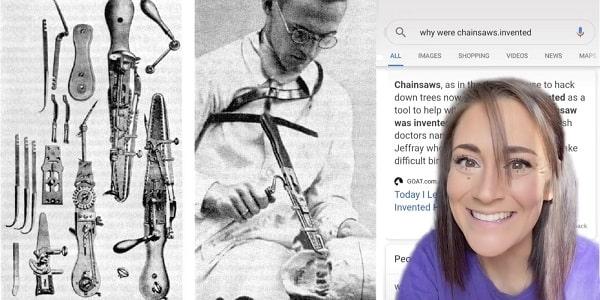The chainsaw is a woodworker’s most handy tool and was first used on women.
Surprisingly no one knows Why Were Chainsaws Invented?. The chainsaw’s original design was very different from what we have today.
Doctors use this tool to cut the body part when the baby is stuck and unable to find its way out from mother’s uterus. The process is likened to what we know as cesarean sections today. However, it was undoubtedly a messy process that led to post-childbirth complications in some women.
Overview
Before the advancement in medicine, the typical way children were delivered was via the opening of the uterus.
However, not all babies can be born this way. Some babies, during delivery, were stuck either by their heads or shoulders, making the whole process complicated.
Doctors invented a tool, the chainsaw, to save the baby’s life and the mother’s. It was small in size with sharp edges. This chainsaw slit the cartilage of the mother’s pubic symphysis.
It widened the pelvis’s diameter, making it more accessible for the body to be pushed out. Although, the change caused to the anatomy of the mother was permanent. Many women could not walk for days, weeks, and sometimes months after the process.
The horrifying aspect is that no anesthesia was administered before the commencement of the procedure.
Why Were Chainsaws Invented?
It has been established in most medical records that using the chainsaw to help with delivery was the primary alternative at that time. The process is known as symphysiotomy or pelviotomy, or synchondrotomy.
The practice was more common in Ireland and Argentina in the 18th century. There are records that this method was used on women in several other parts of the world.
It is believed that the procedure helped reduce the risk of mother-child death.
On the flip side, there were several cases in which women felt this procedure violated their rights as women. Some women lost their babies a few moments after delivery because the baby’s head was injured.
In some cases, the mother developed complications after the process. Complaints about the looseness of the pelvis, difficulty walking, fistula, and a host of others were reported as complications due to symphysiotomy.
Many women in Ireland described the process as plain butchering. Several lawsuits were filed against doctors, hospitals, and the government. The women complained about how the doctors felt they could try such a procedure without seeking their consent.
At a time in Ireland, where the dominant catholic belief was against contraceptives, many women got multiple pregnancies within a short time frame and ordeal.
In seeking justice, the women formed a group called SoS – survivors of symphysiotomy. They all campaigned for compensation and an apology from the government and hospitals for violating their human rights. After a while, the government sought to give the victims monetary compensation. Many were still displeased after that.
The advent of cesarean sections marked a close to this practice. As medicine advanced, more women opted for CS for fear of complications. The cesarean section, which involves making a small cut in the lower abdomen and uterus, seemed more patient-friendly.



Who Invented The First Chainsaw?
The first chainsaw was created by two doctors, James Jeffrey, and John Aitken, in the late 18th century. After its creation, it became an invaluable tool in childbirth procedures and in removing diseased bones.
The inventors are of Scottish origin. They both made relevant contributions to the field of medicine.
James Jeffrey is said to be the one who came up with the idea and design of the tool. He was able to create the tool several years after conceiving the idea.
Why Were Chainsaws Invented for Childbirth?
When babies found it challenging to come out through their mother’s birth canal, doctors had to devise a way to bring the baby out.
The first procedure doctors thought of was using a knife to cut the mother’s pelvis. This procedure was slow, time-consuming, and extremely painful. It sometimes resulted in injuries for both mother and child.
After that, John Aitken and James Jeffrey invented the first chainsaw, which was widely accepted. Unlike the knife, it was faster and easier to cut the cartilage of the pelvis.
The procedure still met some resistance, especially in the era before the creation of anesthesia. The process only applies right after the anesthesia has been given to the mother to reduce cutting pain.
Symphysiotomy is no longer practiced in developed countries like the United Kingdom or the United States as there are adequate facilities to carry out the cesarean section. Some countries in the developing world still carry out this procedure due to the lack of a proper medical facility to aid the cesarean section.
Why were Chainsaws Invented for?
The evolution of chainsaws followed the aging of the world. Its design in medicine helped some creative-minded individuals develop ideas that could be useful in the woodworking industry.
In 1926, Andreas Stihl, a German Engineer, created the first-ever electric chainsaw. It was a massive device that consumed lots of energy but little mechanical force. He is known as the ‘Father of the modern chainsaw.’
The following year, Dolmar, an institution owned by Emil Lerp, improved the existing design creating the first petrol chainsaw. Unlike Stihl’s innovation, it only needed petrol and could function without electricity.
About 23 years later, the first portable chainsaw was created. It became possible following the contributions of Claude Poulan and McCulloch. Poulan realized the tool needed amendment while watching over some prisoners in Germany. Simultaneously, McCulloch was producing handy mechanical devices for the same purpose.
The anti-vibration system chainsaw design was created in 1964. It aimed at reducing the mechanical force required to operate the device.
The chain brake style came to life in 1972, followed by the Quick stop and Catalyzer design in 1982 and 1989, respectively.
Even today, tech companies are still trying to improve the design to create something more portable, effective, and efficient.
The Medical Chainsaws
The theory of use and disuse in science applies to every aspect of life. Medical chainsaws were of great importance for over two centuries.
New inventions came and proved to be more effective. The cesarean section was performed alongside chainsaw procedures for years. At some point, they were both on par regarding effectiveness.
Much work was done on improving the cesarean section procedure and making Childbirth less painful. Over time, the death rate associated with the process declined.
The controversies around the chainsaw procedure contributed to its silencing. Many women feel they were abused due to how it was carried out. Although, it remains a legal and effective procedure that can be swift and effective combined with vacuum and anesthesia.
At some point in the 20th century, mothers who experienced childbirth complications preferred cesarean sections. As it recorded lots of success, it was able to reduce the frequency of the former procedure.
Now, it’s rare to find a medical chainsaw or hospital still carrying out the practice. Thanks to the changes that took place over a continuum of time, women can now have their babies via less painful procedures. Although, there are reports about complications due to CS births. The underlying factor remains the ease of managing complications with this practice.
The standard chainsaws today are reserved for wood and woodworking.
When did chainsaws stop being used for Childbirth?
Using chainsaws for delivery started to decline in the 20th century when the alternative cesarean section procedure became more effective.
Was the chainsaw invented for Childbirth?
It might sound weird and hard to believe, but the chainsaw was meant to be a medical tool to help babies stuck in the mother’s birth canal find their way out. It was created years after James Jeffrey conceived the idea. He made the tool with John Aitken.
How did chainsaws help deliver babies?
The chainsaw was used to swiftly slit a woman’s pubic symphysis cartilage to bring out her baby.
Why did the chainsaw become a meme?
The room could be better lit. A meme has gone viral depicting people’s reactions when they learn why chainsaws were made, and a video on TikTok claims chainsaws were first invented to aid in Childbirth. So, if you’ve come here because you want to know the answer, you’re about to learn it.
When did they stop using chainsaws for Childbirth?
It was used as part of a surgical toolkit throughout much of the 19th century until C-sections became more popular. The principle was repurposed in the 20th century for less obtrusive applications such as logging, with two-person saws weighing more than 100 pounds each. By the 1950s, lighter variants had taken their place.
Conclusion
Chainsaws have a remarkable history. Each stage of its creation and advancement has served as a very effective tool in medicine and woodworking.






